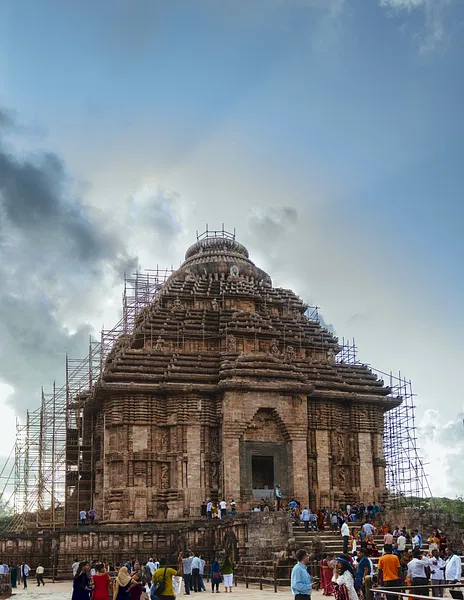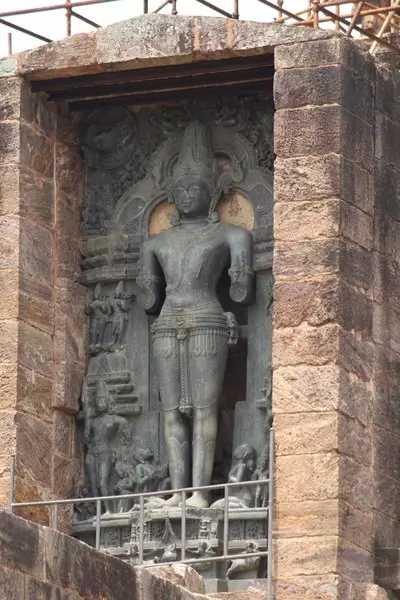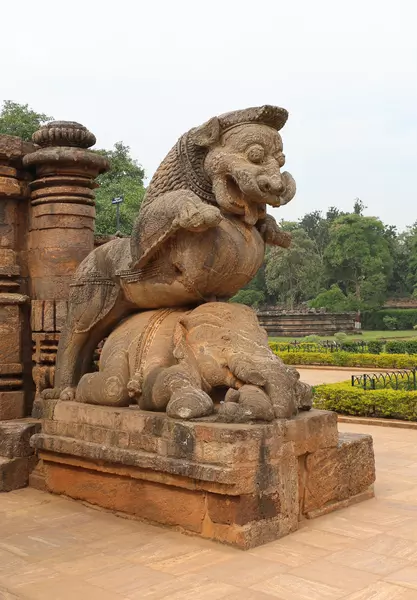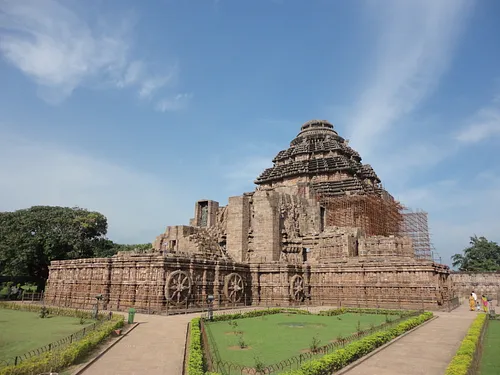The Konark Sun Temple is dedicated to the Hindu god Sun also known as Surya. The entire sculpture of the temple looks like a giant stone chariot with 12 pairs of wheels. It is the most famous among the sun temples built in India (Bharat).
Konark sun temple which is located 35 kilometers northeast from Puri on to the coastline of Orisha, India. Coordinates 19°53’15” N,86°5’41” E on Google map.
The temple was built in the 13th Century (1250) CE by King Narsimhadeva I of the Eastern Ganga dynasty. The present state of the temple was declared by UNESCO a world heritage site in 1984 CE.
Now, the complete carcass of the temple did not remain but remaining voor the temple complex has the appearance of approximately 127 feet high with immense wheels and horses all carcass carved from stone. The complete carcass of the temple is over 227 feet high.
Konark sun temple stands as a classic example of Hindu temple architecture, complete with a colossal structure, sculptures, and the artwork on myriad themes.
Why Konark Was Considered to be the most appropriate place for the construction of a Sun temple?
Konark was considered to be the most appropriate place for construction of a Sun temple because from time immemorial it had special importance as a served center of Sun worship.
Kalinga is considered as the birthplace of Surya and of the four traditional kshetras of Orissa, Bhubaneswar, Puri, Jaipur, and Konark, at the last one was alone associated with the worship of the Sungod. The sanctity of Konark might have been the main consideration for erecting a temple there.
It was erected very near the seashore. In honor of the rising Sun of the sacred places of Orissa, Bhubaneshwar, Puri, and probably Jaipur already had grand temples and therefore Konark was the obvious choice for building a stupendous temple which Fergusson pronounced ‘as the most beautiful in the province’.
The Style of Architecture at Konark Sun Temple.
 |
| Jaganamoana, Konark Sun Temple |
The temple follows the Kalinga of the Orissa style of temple architecture. Which may be a subset of the nagara sort of Hindu temple architecture. The Orissa style is believed to showcase the nagara style in all its purity.
The nagara style was among the three styles of Hindu temple architecture in India (Bharat) and prevailed in northern India (Bharat), while in the south, the Dravida style predominated and in central and eastern India (Bharat), it was the vesara style. This style can be distinguished by how features such as ground plan and elevation were represented visually.
The nagara style is characterized by a square ground plan, containing a sanctuary and assembly hall called mandapa. In terms of elevation, here is a huge curvilinear tower called shikhara, inclining inwards and capped. Although Odisha lies in the eastern region, the “Nagara” style was adopted.
But the question is that “the Orissa is lies in the eastern region and that region is dominated by “vesara” style architecture so how they adopted the “nagara” style of architecture?”
This could be adopted since King Anantavarman’s domains included many areas in northern India (Bharat) also, the design prevalent there decisively impacted the architectural plans of the temple that were about to be built-in Odisha by the king.
Once adopted, the same tradition was continued by his successors too, and with time many additions were made.
The main characteristics of the Orissa style are primarily two: the deul or the sanctum housin the deity covered by a shikhara, and the Jaganamohana or the assembly hall (mandapa).
The latter has a pyramidal roof built up by secession of the receding platform known as pidhas. Both structures are squares internally and use a common platform. The exterior is variegated into projection known during this style as rathas or pagas which create the effect of sunshine and shade. Many temples built in this style show their own peculiar variations, and Konark is no exception.
The style here follows the architecture of the Lingaraja temple built around 1100 CE within the present-day city of Bhubaneshwar, the capital of Odisha, and known locally as the Khakhara style.
In this design, the temple is situated within an outsized quadrangular court enclosed by massive walls and with a huge gate within the east. There are multiple halls dedicated to various activities like dancing, serving meals, gathering, etc. within this complex along with the sanctum and with lofty towers.
Konark excels at the Lingaraja in the nobility of its conception and the perfection of its finish. Grand and impressive even in its ruin, the Konark temple represents the fulfillment and finality of Orissa’s architectural movement.
The Konark temple, built entirely in stone, is within the sort of a huge chariot with 12 pairs of lavishly- ornamented wheels, drawn by seven richly- caparisoned, galloping horses.
The wheels have been carved against the side of the chariot. The conception of this temple within the sort of a chariot has mainly to try to to with Hindu beliefs regarding Surya that he's usually found on a chariot pulled by seven horses.
Thus, the depiction of a chariot invariably become part of any artistic creation related to the sun god in India (Bharat). The 12 pairs of wheels carved side of the wall is represent the 12 months of the year.
The deul including the Glorius shikhara has been lost with time. Today, only the jaganamonaha and therefore the pillared bhoga mandapa, also referred to as the nata mandapa (dancing hall) due to the various sculptures of dancers and musicians on its walls and pillars, in front, remain.
Why Narsimhadeva I built this Temple?
The exact reason for the building of the temple by
Narsimhadeva is not known. Historians have surmised that the king did so either
to express his gratitude for a wish-fulfillment or to commemorate a conquest.
Also, he could have done it simply to show his devotion to Surya, but not
without adding his view of life as seen from the King's perspective.
The complete structure of Konarak Sun temple
This is proven by the sculptures depicting royal activities, including hunts, procession, and military scenes, which emphasizes the fact that the sun temple is the realization of the dazzling dream of an ambitious and mighty king, secular to the core with an immense zest for life.
Even in the sanctuary, the holiest spot in Hindu temple, sculptures in niches depicting secular issues; the subject matters of niches inside the pavilions, with one exception where a preacher-like figure is seen seated in meditation, centers on the life of the king in the palace. Thus, in one niche, an armed king is seen fondly regarding his reflection during a mirror.
Which Stones was used in the construction of the Konark sun temple?
Three kinds of stone have been used in the temple’s construction- Chlorite, Laterite, and Khondalite. Khondalite was used throughout the memorial, while chlorite was confined to a pair of doorframes and sculptures, while laterite was used in inspiration, the invisible core of the plate form, and in the staircases.
None of these stones was available near the site so the material was brought long distances. The stone blocks were lifted possibly by the means of pulleys, wooden wheels, or rollers and then set into place. The fitting and finishing were done so smoothly that the joints could not be seen.
The Sculptures of Konark sun temple
During Narasimhadeva’s region, eastern Ganga art reached its peak. In Konark, therefore, the sculpture displays these heights; Nowhere is it that this era of Kalinga sculpture is represented in comparison to the large and miniature carvings that adorn Jaganamohana of the stone temple at Konark.
Every bit of space available has been covered by the
sculpture and with what appears as an endless variety of themes, with figures
indulging in song and dance and activities related to Kama (desires and sensual
enjoyment). There are also depictions of mythical beings, birds and animals,
besides the flora and geometrical motifs. The designs were carved after the
stones were installed in place.
Sculptures at Konark Sun Temple
Panels represent king Narsimhadeva in various roles- as a scholar reviewing literary works being presented to him by poets, as enjoying himself on a swing in his palace, as a great archer, and as a deeply religious devotee.
These are made from pink and green Khondalite. these depictions dominate to such an extent that it appears that the sculpture was so busy highlighting the myriad facets of royal life that they had very little scope to record the daily life of the common man.
 |
| Sun God, Konarak Sun Temple |
A colossal idol of Surya within the southern niche of the sanctuary may be a characteristic sculpture of this temple. It is also one of the very few sculptures in India (Bharat) which shows a god wearing boots.
This can be attributed to the central Asian influence on Indian art, owning to the region of Scythian- origin dynasties of ancient India (Bharat). God is shown standing on his chariot drawn by seven horses. The entire sculpture stands on a chlorite pedestal and is made from a single piece. It is 3.38 meters high, 1.8 meters wide and 71 cm thick.
The sun god even wearing the short lower garment in the drawer style (one end of the garment dawn between the legs and tucked in the waist at the back) and many ornaments. These include a girdle at the waist, a necklace of 5 beaded strings with a central clasp, armlets, earrings, and a crown. These are carved with such intricacy that every bead and motif is visible.
The hair is worn during a bun on the crown of the top. A halo is seen around the heads, with tongues of flames protruding outwards. He holds a lotus stalk in both his hands and is surrounded by many retinues figures, including celestial dancers, and thus the king obeys with his family priest.
Pairs of animals were also made to guard the three
staircases of the porch in different directions, and are regarded as
masterpieces of the sculpture art of the Odisha region. These include two
rampant lions standing on crouching elephants in the east, gaily decorated and
harnessed elephant to the north, and two beautifully caparisoned warhorses to
the south. 
Rampant lions, Konarak sun temple
The elephants and horses have since re-installed on new pedestals only a few meters distant from the original locations and now face the porch. The lions-on-elephant now lie to the front of the eastern stairs of the bhoga-mandapa. Though covered with plaster, the original color of this sculpture was dark red patches of which are still visible.
One of the extant sculptures of a warrior standing alongside one of the horses. Now headless, he sports a scabbard down his back, while a quiver full of arrows is seen tied to the saddle. The horse is seen crushing one figure under his hooves, while another lies below his body.
How does the Konark sun temple collapse?
Even in medieval times, Konark became a famous temple, and references are discovered in literary works. Along with the Jagannatha temple, it served as a landmark for sailor sailing the Bay of Bengal.
Early Europeans crossing this sea referred to the Jagannath temple as the 'White Pagoda' and Konark as the owner of the 'Black Pagoda'.
The reasons for the collapse of the deul and the shikhara are not as yet known. It is believed that it occurred due to the subsidence of the foundation, while others speak of an earthquake or lightning, yet others doubt if the temple was ever completed.
The main belief is that the temple crumbles gradually, as the use of poor quality Khondalite led to the temple’s eventual decay. Many people ascribe the beginning of this action to the attack by Islamic invaders.
The image of the presenting deity or Surya has also never been found and hence it is not known as to what shape, or size it originally was. The speculation surrounding it again offers the voice of many ideals, inclusive of its destruction or elimination to the Jagannath temple. The loss of the deity caused the temple to be neglected, eventually causing its decay.
Rediscovery and Restoration of the Konarak sun temple
James Fergusson, the noted Scottish historian of British India (Bharat) who played a key role in rediscovering ancient Indian antiquities and architectural sites visited Konarak in 1837 CE and prepared a drawing.
He estimated the height of the portion still standing as being between 42.67 and 45.72 meters. By 1868 CE, the site was decreased to a mass of stones covered through trees here and there.
Fergusson wrote that a local raja (King) had removed some sculptures to enhance a temple he became a building in his very own citadel and that the temple itself became one way or the other saved from being utilized in building a lighthouse Besides the Raja, the local was also not inactive in removing the fallen stones and taking out the iron clamps and dowels.
Conservation activities gained momentum after 1900CE after Lt. Governor John Woodburn started a planned campaign to save the temple at any cost by adopting appropriate measures. Since 1939, CE the Archaeological Survey of India has been conserving and maintaining the site.





1 Comments
Such an incredible piece of history! The Konark Sun Temple is truly a masterpiece of ancient Indian architecture and engineering. The intricate carvings and the sheer grandeur of the structure are awe-inspiring. It’s amazing how much culture, art, and spirituality are embedded in every corner of this temple. A must-see for anyone who appreciates history and architectural beauty!
ReplyDelete